NVIDIA Optimus - Truly Seamless Switchable Graphics and ASUS UL50Vf
by Jarred Walton on February 9, 2010 9:00 AM ESTASUS UL50Vf General Performance

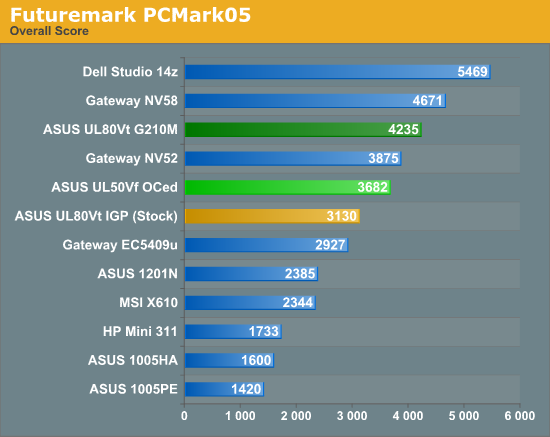
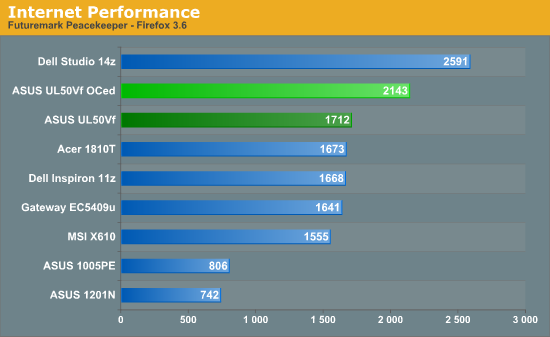
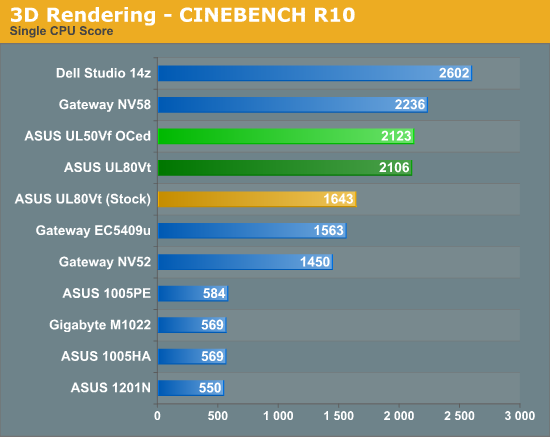
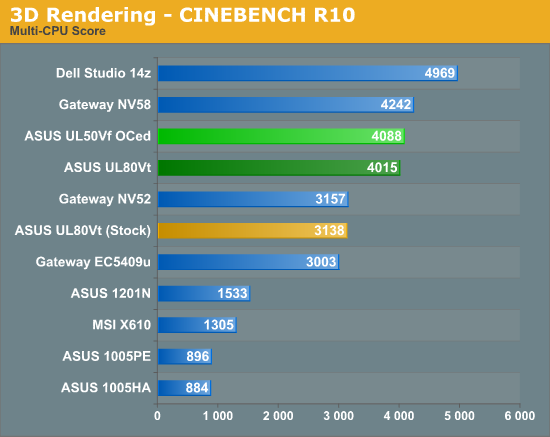

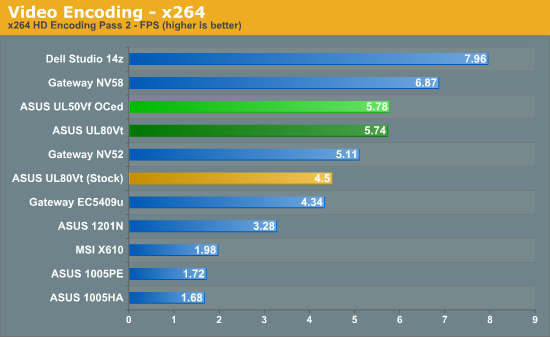
General performance is what you would expect from an overclocked CULV with G210M. It's not going to outperform higher end CPU/GPU configurations, but for a large number of users it will do very well. As we've mentioned before, CULV is generally more than three times as fast as netbook Atom (N280/N450) and yet it doesn't cost three times as much. Add on the 33% overclock with the UL50Vf and the lead only increases. We do see some minor performance variations when comparing the UL50Vf with the UL80Vt, but the scores are close enough that slight differences in drivers and components can account for the change.










49 Comments
View All Comments
MasterTactician - Wednesday, February 10, 2010 - link
But doesn't this solve the problem of an external graphics solution not being able to use the laptop's display? If the external GPU can pass the rendered frames back to the IGP's buffer via PCI-E than its problem solved, isn't it? So the real question is: Will nVidia capitalize on this?Pessimism - Tuesday, February 9, 2010 - link
Did Nvidia dip into the clearance bin again for chip packaging materials? Will the laptop survive its warranty period unscathed? What of the day after that?HighTech4US - Tuesday, February 9, 2010 - link
You char-lie droid ditto-heads are really something.You live in the past and swallow everything char-lie spews.
Now go back to your church's web site semi-inaccurate and wait for your next gospel from char-lie.
Pessimism - Tuesday, February 9, 2010 - link
So I suppose the $300+ million dollars in charges Nvidia took were merely a good faith gesture for the tech community with no basis in fact regarding an actual defect.HighTech4US - Tuesday, February 9, 2010 - link
The $300+ million was in fact a good faith measure to the vendors who bought the products that had the defect. nVidia backed extended warranties and picked up the total cost of repairs.The defect has been fixed long ago.
So your char-lie comment as if it still exists deserves to be called what it is. A char-lie.
Pessimism - Tuesday, February 9, 2010 - link
So you admit that a defect existed. That's more than can be said for several large OEM manufacturers.Visual - Tuesday, February 9, 2010 - link
Don't get me wrong - I really like the ability to have a long battery life when not doing anything and also have great performance when desired. And if switchable graphics is the way to achieve this, I'm all for it.But it seems counter-productive in some ways. If the external GPU was properly designed in the first place, able to shut down power to the unused parts of the processor, supporting low-power profiles, then we'd never have needed switching between two distinct GPUs. Why did that never happen?
Now that Intel, and eventually AMD too, are integrating a low-power GPU inside the CPU itself, I guess there is no escaping from switchable graphics any more. But I just fail to see why NVidia or ATI couldn't have done it the proper way before.
AmdInside - Tuesday, February 9, 2010 - link
Because it's hard to compete with a company that is giving away integrated graphics for free (Intel) in order to move higher priced CPUs. In a way, AMD is doing the same with ATI. Giving us great motherboards with ATI graphics and cheap cheap prices (which in many ways are much better than Intel's much higher priced offerings) in order to get you to buy AMD CPUs.JarredWalton - Tuesday, February 9, 2010 - link
Don't forget that no matter how pieces of a GPU go into a deep sleep state (i.e. via power gate transistors), you would still have some extra stuff receiving power. VRAM for example, plus any transistors/resistors. At idle the CULV laptops are down around 8 to 10W; even the WiFi card can suck up .5 to 1W and make a pretty substantial difference in battery life. I'd say the best you're likely to see from a discrete GPU is idle power draw that's around 3W over and above what an IGP might need, so a savings of 3W could be a 30% power use reduction.maler23 - Tuesday, February 9, 2010 - link
I've been waiting for this article ever since it was hinted in the last CULV roundup. The ASUS laptop is a little disappointing, especially the graphic card situation(the Alienware M11X kind of sucked up a lot of excitement there). Frankly, I'd just take a discounted UL-30VT and deal with manual graphics switching.Couple of questions:
-Any chance for a review of the aforementioned Alienware M11X soon?
-I've seen a couple of reviews with display quality comparisons including this one. How do to the Macbook and Macbook Pros fit into the rankings?
cheers!
-J